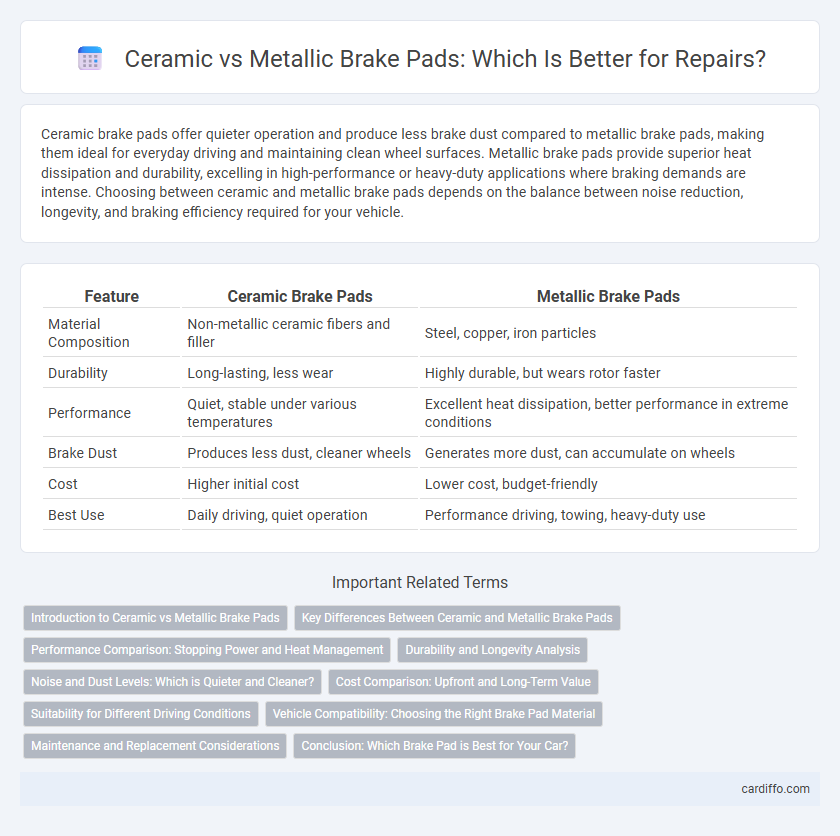Ceramic brake pads offer quieter operation and produce less brake dust compared to metallic brake pads, making them ideal for everyday driving and maintaining clean wheel surfaces. Metallic brake pads provide superior heat dissipation and durability, excelling in high-performance or heavy-duty applications where braking demands are intense. Choosing between ceramic and metallic brake pads depends on the balance between noise reduction, longevity, and braking efficiency required for your vehicle.
Table of Comparison
| Feature | Ceramic Brake Pads | Metallic Brake Pads |
|---|---|---|
| Material Composition | Non-metallic ceramic fibers and filler | Steel, copper, iron particles |
| Durability | Long-lasting, less wear | Highly durable, but wears rotor faster |
| Performance | Quiet, stable under various temperatures | Excellent heat dissipation, better performance in extreme conditions |
| Brake Dust | Produces less dust, cleaner wheels | Generates more dust, can accumulate on wheels |
| Cost | Higher initial cost | Lower cost, budget-friendly |
| Best Use | Daily driving, quiet operation | Performance driving, towing, heavy-duty use |
Introduction to Ceramic vs Metallic Brake Pads
Ceramic brake pads offer quieter operation, less brake dust, and longer lifespan compared to metallic brake pads, which provide superior heat dissipation and better performance under extreme braking conditions. Metallic pads, made from a blend of steel, iron, and other metals, excel in heavy-duty and high-performance applications but tend to produce more noise and brake dust. Choosing between ceramic and metallic brake pads depends on driving habits, vehicle type, and performance requirements.
Key Differences Between Ceramic and Metallic Brake Pads
Ceramic brake pads offer quieter operation, reduced brake dust, and longer lifespan compared to metallic brake pads, which provide superior performance in extreme temperatures and heavy-duty braking conditions. Ceramic pads maintain consistent braking with less rotor wear, while metallic pads excel in heat dissipation and durability under aggressive driving or towing. Choosing between ceramic and metallic brake pads depends on driving style, vehicle type, and maintenance preferences.
Performance Comparison: Stopping Power and Heat Management
Ceramic brake pads offer consistent stopping power with less noise and produce minimal brake dust compared to metallic brake pads, which deliver superior performance under extreme conditions due to better heat dissipation. Metallic pads excel in heat management, maintaining braking efficiency and reducing fade during intense or prolonged use, making them ideal for high-performance or heavy-duty vehicles. Ceramic pads, while less effective at managing high temperatures, provide smoother braking and longer pad life in everyday driving scenarios.
Durability and Longevity Analysis
Ceramic brake pads offer superior durability due to their resistance to heat and wear, maintaining consistent performance over extended periods. Metallic brake pads, while robust, tend to wear faster under high-temperature conditions, reducing their overall lifespan. Choosing ceramic pads enhances longevity by minimizing pad degradation and brake system wear.
Noise and Dust Levels: Which is Quieter and Cleaner?
Ceramic brake pads generate significantly less noise compared to metallic brake pads, offering a quieter driving experience. They also produce finer, lighter-colored dust that is less likely to accumulate on wheels, keeping them cleaner over time. In contrast, metallic brake pads tend to create louder squealing sounds with coarser, darker dust that can be harder to clean.
Cost Comparison: Upfront and Long-Term Value
Ceramic brake pads generally cost more upfront, ranging from $50 to $150 per set, compared to metallic brake pads, which typically range from $30 to $75 per set. The long-term value of ceramic pads is higher due to their enhanced durability, producing less brake dust and reducing wear on rotors, which can lower maintenance expenses. Metallic pads wear faster and generate more noise, potentially increasing replacement frequency and overall lifetime costs despite their lower initial price.
Suitability for Different Driving Conditions
Ceramic brake pads are ideal for everyday city driving and light-duty use due to their low dust production, quieter operation, and stable performance under moderate temperatures. Metallic brake pads excel in high-performance and heavy-duty conditions, offering superior heat dissipation, enhanced stopping power, and greater durability in aggressive driving or towing scenarios. Selecting between ceramic and metallic brake pads depends on driving habits, vehicle type, and specific performance requirements for safety and longevity.
Vehicle Compatibility: Choosing the Right Brake Pad Material
Ceramic brake pads offer superior compatibility with a wide range of passenger vehicles, providing quieter operation and less wear on rotors, ideal for daily commuting and light-duty driving. Metallic brake pads, known for their durability and heat dissipation, suit high-performance and heavy-duty vehicles, especially those frequently subjected to aggressive braking or towing. Matching brake pad material to vehicle type ensures optimal braking efficiency, safety, and longevity of braking components.
Maintenance and Replacement Considerations
Ceramic brake pads require less frequent maintenance due to their resistance to wear and reduced dust production, making them ideal for drivers seeking low-maintenance options. Metallic brake pads tend to wear out faster and generate more noise and dust, necessitating more frequent inspections and replacements, especially in high-performance or heavy-duty vehicles. Proper maintenance schedules for metallic pads are crucial to prevent rotor damage, while ceramic pads offer longer service life with minimal upkeep.
Conclusion: Which Brake Pad is Best for Your Car?
Ceramic brake pads offer quieter operation, less dust, and longer lifespan, making them ideal for daily commuting and light to moderate driving conditions. Metallic brake pads provide superior heat dissipation and better performance under heavy braking, suited for high-performance vehicles or towing. Choose ceramic pads for comfort and longevity or metallic pads for aggressive driving and maximum braking power.
ceramic brake pads vs metallic brake pads Infographic

 cardiffo.com
cardiffo.com